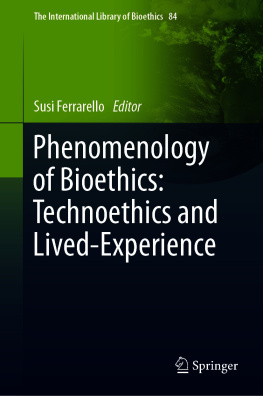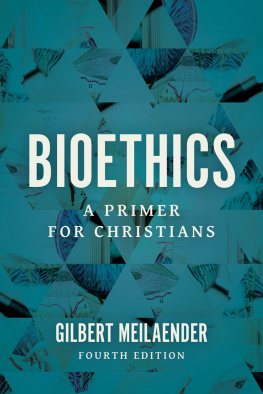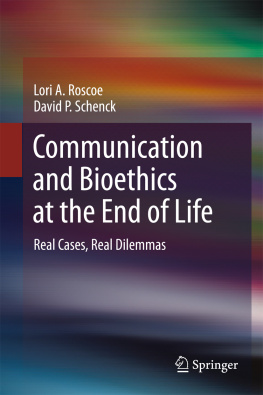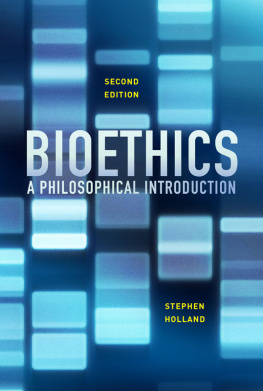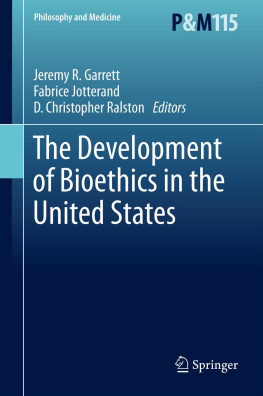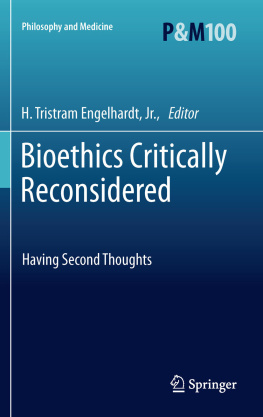J.A. Bryant - Introduction to Bioethics
Here you can read online J.A. Bryant - Introduction to Bioethics full text of the book (entire story) in english for free. Download pdf and epub, get meaning, cover and reviews about this ebook. year: 2018, publisher: Wiley-Blackwell, genre: Romance novel. Description of the work, (preface) as well as reviews are available. Best literature library LitArk.com created for fans of good reading and offers a wide selection of genres:
Romance novel
Science fiction
Adventure
Detective
Science
History
Home and family
Prose
Art
Politics
Computer
Non-fiction
Religion
Business
Children
Humor
Choose a favorite category and find really read worthwhile books. Enjoy immersion in the world of imagination, feel the emotions of the characters or learn something new for yourself, make an fascinating discovery.

- Book:Introduction to Bioethics
- Author:
- Publisher:Wiley-Blackwell
- Genre:
- Year:2018
- Rating:4 / 5
- Favourites:Add to favourites
- Your mark:
- 80
- 1
- 2
- 3
- 4
- 5
Introduction to Bioethics: summary, description and annotation
We offer to read an annotation, description, summary or preface (depends on what the author of the book "Introduction to Bioethics" wrote himself). If you haven't found the necessary information about the book — write in the comments, we will try to find it.
Introduction to Bioethics — read online for free the complete book (whole text) full work
Below is the text of the book, divided by pages. System saving the place of the last page read, allows you to conveniently read the book "Introduction to Bioethics" online for free, without having to search again every time where you left off. Put a bookmark, and you can go to the page where you finished reading at any time.
Font size:
Interval:
Bookmark:

- Chapter 01
- Chapter 10
- Chapter 13
- Chapter 01
- Chapter 03
- Chapter 04
- Chapter 05
- Chapter 06
- Chapter 07
- Chapter 09
- Chapter 10
- Chapter 12
- Chapter 13
- Chapter 14
Second Edition
John A. Bryant
University of Exeter
Exeter, UK
Linda la Velle
University of Plymouth
Plymouth, UK

This edition first published 2019
2019 John Wiley & Sons Ltd
All rights reserved. No part of this publication may be reproduced, stored in a retrieval system, or transmitted, in any form or by any means, electronic, mechanical, photocopying, recording or otherwise, except as permitted by law. Advice on how to obtain permission to reuse material from this title is available at http://www.wiley.com/go/permissions.
The right of John A. Bryant and Linda la Velle to be identified as the authors of this work has been asserted in accordance with law.
Registered Office(s)
John Wiley & Sons, Inc., 111 River Street, Hoboken, NJ 07030, USA
John Wiley & Sons Ltd, The Atrium, Southern Gate, Chichester, West Sussex, PO19 8SQ, UK
Editorial Office
The Atrium, Southern Gate, Chichester, West Sussex, PO19 8SQ, UK
For details of our global editorial offices, customer services, and more information about Wiley products visit us at www.wiley.com.
Wiley also publishes its books in a variety of electronic formats and by printondemand. Some content that appears in standard print versions of this book may not be available in other formats.
Limit of Liability/Disclaimer of Warranty
While the publisher and authors have used their best efforts in preparing this work, they make no representations or warranties with respect to the accuracy or completeness of the contents of this work and specifically disclaim all warranties, including without limitation any implied warranties of merchantability or fitness for a particular purpose. No warranty may be created or extended by sales representatives, written sales materials or promotional statements for this work. The fact that an organization, website, or product is referred to in this work as a citation and/or potential source of further information does not mean that the publisher and authors endorse the information or services the organization, website, or product may provide or recommendations it may make. This work is sold with the understanding that the publisher is not engaged in rendering professional services. The advice and strategies contained herein may not be suitable for your situation. You should consult with a specialist where appropriate. Further, readers should be aware that websites listed in this work may have changed or disappeared between when this work was written and when it is read. Neither the publisher nor authors shall be liable for any loss of profit or any other commercial damages, including but not limited to special, incidental, consequential, or other damages.
Library of Congress CataloginginPublication Data
Names: Bryant, J. A., author. | Baggott la Velle, Linda, author.
Title: Introduction to bioethics / by John A. Bryant and Linda la Velle.
Description: Second edition. | Hoboken, NJ : WileyBlackwell, 2018. | John Bryant, University of Exeter, Exeter, UK; Linda la Velle, University of Plymouth, Plymouth, UK. | Includes bibliographical references and index. | Identifiers: LCCN 2017061639 (print) | LCCN 2018000727 (ebook) | ISBN 9781118719589 (pdf) | ISBN 9781119080152 (epub) | ISBN 9781118719619 (hardback) | ISBN 9781118719596 (paper)
Subjects: LCSH: Bioethics. | BISAC: SCIENCE / Life Sciences / General.
Classification: LCC QH332 (ebook) | LCC QH332 .B79 2018 (print) | DDC 174.2dc23
LC record available at https://lccn.loc.gov/2017061639
Cover Design: Wiley
Cover Images: (Corn) Candus Camera/Shutterstock; (intracytoplasmic sperm injection) Phanie / Alamy Stock Photo; (Sheep) Binnerstam/Gettyimages; (DNA sequence) Gio_tto/Gettyimages; (Tobacco cells) Courtesy of Dr Dennis Francis; (Mouse) Bliznetsov/Gettyimages; (Sky) spooh/Gettyimages; (Forest) AustralianCamera/Shutterstock
Each new power won by man is a power over man as well. Each advance leaves him weaker as well as stronger. In every victory, besides being the general who triumphs, he is also the prisoner who follows the triumphal car.
These words, written in 1947 by the scholar of medieval English, CS Lewis, headed the Preface of the first edition of this book. The quotation, from the book The Abolition of Man, illustrates the ambiguity inherent in many scientific advances and technological inventions: they can be used for good or bad. It is probable that one of the issues that Lewis had in mind was nuclear fission but we can trace similar concerns down through the decades in other fields, including medicine, agriculture and biotechnology.
The idea is also expressed well by the historian Francis Fukuyama in his 2002 book, Our Posthuman Future:
Biotechnology presents us with a special moral dilemma, because any reservations we may have about progress need to be tempered with a recognition of its undisputed promise.
Thus, there has been a growing awareness of the need for informed discussion on the ethical issues arising in biological and biomedical sciences. This has led to bioethics courses being added to university degree programmes in life sciences, thus providing the impetus for our first edition, which was specifically written for students as well as for academics who were not yet engaged with bioethical issues. Feedback from members of our target audiences has been very positive and this has encouraged us to produce this second updated edition. Progress in many areas of biological and biomedical science has been spectacular in the 13 years since the first edition was published, providing huge opportunities for new developments in medicine, agriculture and biotechnology but also raising new ethical issues (or at the least, new versions of old ethical issues). Further, this is set against a background of the expanding human population of our planet and of increasing concern about environmental issues, especially climate change.
All this has led us to an almost complete reworking of the book, although several useful case studies and examples from the first edition remain in this one. We have tried to be as up to date as is humanly possible but the speed of progress means that for some topics discussed here, further developments will have taken place in the few months between completion of the manuscript and publication. However, we will provide updates plus links to other relevant material on the books website www.wiley.com/go/Bryant/IntroductiontoBioethics2e, which will provide a very useful adjunct to the text.
It is a pleasure to express our thanks to the many people who have helped us in our thinking. First we must mention John Searle, our coauthor for the first edition but who, because of other commitments, has been unable to work with us on this edition. Nevertheless, he has always been willing to discuss bioethical issues, especially those arising at the end of life. We are very grateful for his support. We continue to be grateful to all those who helped us during our writing of the first edition. It has been a privilege for JB to work with Chris Willmott in our roles as bioethics advisors to the UKs Higher Education Academy, during which we have enjoyed ongoing discussions of many bioethical issues. In relation to specific topics in this edition, we thank Alex Aylward and members of South West NHS Genomic Medicine Centre, Exeter (human genetics and genomics); Suzi Leather and Philippa Taylor (fertility issues and human embryology); Elaine Storkey (selective abortion); John CliftonBrown, John Love and David Stafford (biofuels); Margot Hodson, Martin Hodson, Rachel Oates and Chris Southgate (environmental issues); Steve Hughes (GM crops and biofuels); Hannah Farrimond (science/ethics); Tim Miller (for introducing us to futurology literature); Mike Fowler (genetic piracy in relation to phytopharmacology).
Next pageFont size:
Interval:
Bookmark:
Similar books «Introduction to Bioethics»
Look at similar books to Introduction to Bioethics. We have selected literature similar in name and meaning in the hope of providing readers with more options to find new, interesting, not yet read works.
Discussion, reviews of the book Introduction to Bioethics and just readers' own opinions. Leave your comments, write what you think about the work, its meaning or the main characters. Specify what exactly you liked and what you didn't like, and why you think so.



